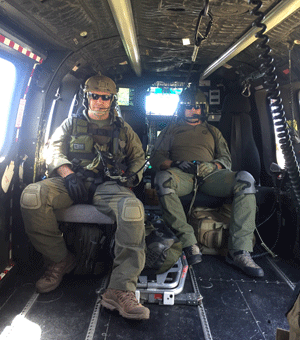 This article was written with the assistance of George Creamer and Rich Diliberti. George Creamer worked for a large metropolitan sheriff’s department in the Southern California area for almost 32 years, with just over 15 years with the SWAT team. Rich Diliberti has worked and continues to work for the same sheriff’s department for 29 years, 15 years working for the SWAT team. 3 years ago he moved over to the tactical medical portion of the SWAT team unit, and is now a full-time tactical paramedic for the SWAT team with a secondary responsibility of doing helicopter rescue operations in the very rural parts of the Angeles National Forest and other areas within the county that are inaccessible by ground. George and Rich are owners of Integrated Tactical Concepts which provides training for SWAT teams around the United States.
This article was written with the assistance of George Creamer and Rich Diliberti. George Creamer worked for a large metropolitan sheriff’s department in the Southern California area for almost 32 years, with just over 15 years with the SWAT team. Rich Diliberti has worked and continues to work for the same sheriff’s department for 29 years, 15 years working for the SWAT team. 3 years ago he moved over to the tactical medical portion of the SWAT team unit, and is now a full-time tactical paramedic for the SWAT team with a secondary responsibility of doing helicopter rescue operations in the very rural parts of the Angeles National Forest and other areas within the county that are inaccessible by ground. George and Rich are owners of Integrated Tactical Concepts which provides training for SWAT teams around the United States.
Hostage Rescue
One of the biggest challenges that most SWAT teams want to overcome as it relates to hostage rescue is the scenario-based portion of the training. Being able to shoot accurately simply requires time on the range. Being able to move efficiently through a house simply requires time over and over and over again going through those movement drills inside of whatever training structure is available. Those are very easy things to become proficient in. The difficulty in hostage rescue is personnel management. The priorities of what positions need to be filled first, and being able to be a very quick thinking tactician and be able to bring that pendulum of advantage back towards the center.
In hostage rescue, you are very much at the disadvantage as a tactical team because you have no idea what is occurring inside of the house. You have to quickly position certain people in certain places, and start gathering information and be able to be a very quick thinking tactician. That is probably the number one thing Integrated Tactical Concepts emphasizes during hostage rescue training, is you’re there, and it’s like a chess game. You’re there to out think the crook. If you can put things in place and come up with a very swift plan that you can implement, you’re bringing that level of disadvantage down, and you’re creating more of an even playing field.
What SWAT Teams Train to Overcome
The biggest thing for teams to overcome is putting them through scenario after scenario, so that they can learn from their mistakes in the training environment, so they don’t learn from those mistakes on a real operation. One of the more significant hostage rescue operations that Rich was involved on that helped him develop these training points that they try to provide to these other agencies was a gunman who went into an open and very crowded barbecue restaurant in a city in the southeast part of Los Angeles. The significant part of it was it was immediate that the gunman’s propensity for violence was there, because he was already shooting it out with the patrol officers and trying to shoot at the helicopters.
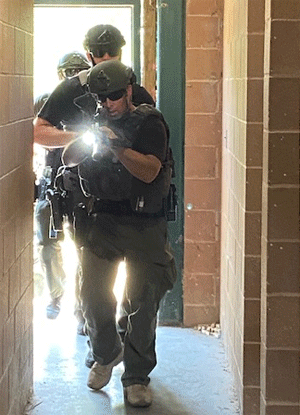
It was about 45 to 50 SWAT operators from his unit showed up. they probably replaced about 25 to 30 patrol officers from about four different agencies. They put all of their pieces in place that they wanted to have available to be able to resolve this, whether it be peacefully or not, but they had to put their personnel in the proper places. That’s where the priorities of who needs to be placed, where and when come in, and all of this was being coordinated. It was probably nine o’clock at night, and people (SWAT personnel) were coming from home, so they were coming from all over the county. This was all being done via the radio; some of it was being done on cell phones.
The situation resolved itself we’ll say, and the hostages were all rescued unharmed. The significance of that and the reason why it was such a learning experience that they (Integrated Tactical Concepts) try to impart on their students is everything he just described to include the driving time to get to the location from all over where everybody lived was 45 minutes. That’s how fast it was. All of that happened in a span of 45-minutes. That is something that most tactical teams in the country will probably never experience.
They feel it’s their responsibility to debrief that incident and explain how they did it, why they did it, and why it was successful the way they decided to plan it. To their law enforcement students students, that information is very, very valuable because they may never get that opportunity.
Suspect Recently out of Prison
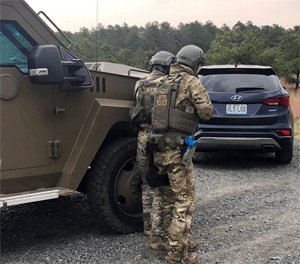
The apartment that they were in was more just a studio, that’s all it was. It was a bedroom, living room area with a small kitchen, a small bathroom. If it turned into a crisis where they had to go inside, they would obviously take the team in there and try and rescue the hostages. What they came up with a plan based upon information that the hostages were in the bathroom of that place, and they were on a cell phone.
Coming up with a SWAT Plan
They had the team that was in the back of the apartment building, even though it was on a second story, get a couple fire department ladders. While the windows were being covered, the team was able to get up to the second floor using the ladders and get those two elderly people out of the apartment and down the ladder to safety. Now granted that whole process took about four hours, and that right there puts everybody at ease. Now their not dealing with a hostage problem. Now they’re dealing with a barricaded problem and that’s exactly what they wanted to do. It doesn’t always have to be this dynamic entry and shoot things up and all that. They don’t want to do that.
Active Shooter Training
The obstacles that officers are trying to overcome when they come to train as far as the active shooter is quite frankly, they just want to know what their role is, and what they try to do is break it down and keep it completely simple.
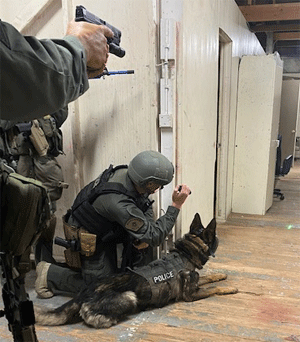
Well, statistically, what they are dealing with as far as active shooters? These things are over within six to 10 minutes maybe and even faster than that. The training is really for that first responder. Now that first responder could be a SWAT guy, that first responder could be a school resource officer, that first responder could be the guy doing the, “Hey, do you mind running down the street and picking up lunch?” It could have been that guy. The training that they provide is to just put the students (law enforcement) in the right mindset to be prepared to respond to anything of that nature, where they’re going to have confidence in themselves. They’re going to have their equipment up and running and ready to go.
Meaning, they have an active shooter vest, where instead of just a regular vest, they can just jump in the back of their trunk of their car. They can throw a piece of body armor on that’s going to be rifle rated, and it’s got a radio attached to it and off they go, because this is going to be another scenario where the intelligence is extremely important. The issue that they see with a lot of the training is that especially now when they’re talking about the one person training, or the one person doing the entry to solve the problem, that’s all fine and dandy until you’ve got three to four different suspects that. That is a suicide mission. If you’ve got three or four suspects inside of some business or something and they’re randomly shooting at people, yes, you have to do something.
Approaching an Active Shooter Situation
You have to get in there and you have to do something, but you want to be able to solve the problem the best you can, not become part of the problem. Now you can you get in there and start providing intel and get to where you need to go and possibly lessen the threat level in there? Meaning, if there’s four, can you take out two? Can you deal with it that way? That very well could be, but at the same time, do you need to run inside there and end up getting another law enforcement officer shot? Here’s how they look at it as far as the priority of life. You have to do something to get in there. This person is actively killing people. You have to get in there. You have to do what you can, but don’t put yourself into a position to where you’re going to end up the next person dead on the floor for a suicide mission.
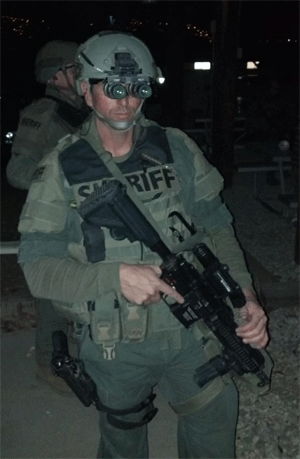
For an example, you take the active shooter that occurred in Saugus, California, about a year and a half ago or so. The first responding officers that were there were there within like minutes because they were off duty, and they heard what was going on, but even being off duty, they had enough of the training where they knew exactly what they were going to do. The bigger part of that was even though there was nobody actively shooting and firing, information was coming in. That information is pertinent, so that you can get it out to those that are still responding to the problem.
Biggest Challenge of an Active Shooter Situation
One of the biggest challenges responding and dealing with active shooters because they have dealt with actual active shooter incidents, several of them quite honestly since we’ve been on both in patrol and on the SWAT team is the level of chaos with regards to the communication and the information being put out on radios and within the law enforcement community when these things are happening, they can’t even describe to you how difficult it is to sift through the massive amount of information that’s coming from a hundred different directions and trying to sift through the stuff that you just need to know in order to try to resolve this as quickly as you can. As soon as an active shooter situation unfolds, it is like radio chaos, and it happens almost every single time.
One of the things when they’re putting on active shooter training, they try really hard to impart on the students (law enforcement) is if there’s someone who can just take the handle, take the lead and start disseminating a plan and some information, that’s the better way to go versus just information being flung from 20 different directions, because all that does is create confusion. It adds to the delay of the response, and unfortunately could add to more casualties. One of the active shooter situations that Rich was directly involved in that plays a part in our training was it was an active shooter situation at Santa Monica College, where they responded along with probably three or four other tactical teams to the college, because of the massive amount of the area.
The information they were receiving as they were driving there was the suspect was dressed in full tactical gear. You can imagine the concern that they were having as they were descending on the college. they were being told that there suspect was dressed just like us, and there were four other tactical teams that had different types of uniforms than they had. Now you have four tactical teams descending on a college, where an active shooter is running loose, wearing the same clothing that you’re wearing. This became a massive piece of information for us.
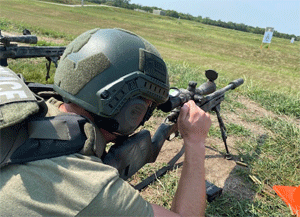
One of the acting shooter situations they we were involved in and when people say an active shooter, a lot of times they immediately go to the high school, a Columbine thing or a medical building or something like that, but this one was actually a residential active shooter. It started off as a warrant service from the federal ATF, and that warrant service went bad. The suspect had barricaded himself inside the house and was actively shooting at every single law enforcement officer and around that neighborhood that he could possibly get to.
When They talk about training for this situation, yes, they do focus their training on structures and things of that nature, but again, They like to make sure that the patrol folks that are out there that are going to be the first responders to these things understand that they understand it may not be that that type of a scenario, and it may be a residential or something like that. This person had a rifle, and they were putting bullets all over the neighborhood, and so that lends to a type of training now more than just movement and moving to contact to us to a suspect. How are they going to rescue these people in this neighborhood that are falling under heavy rifle fire? they like to cover the whole gamut there. There’s active shooter over here, active shooter there in the building, the school, whatever, but there’s also this guy that wants to shoot up the neighborhood and all the cops. How are they going to deal with that scenario.
Related Links

 Joseph Libowsky,
Joseph Libowsky,